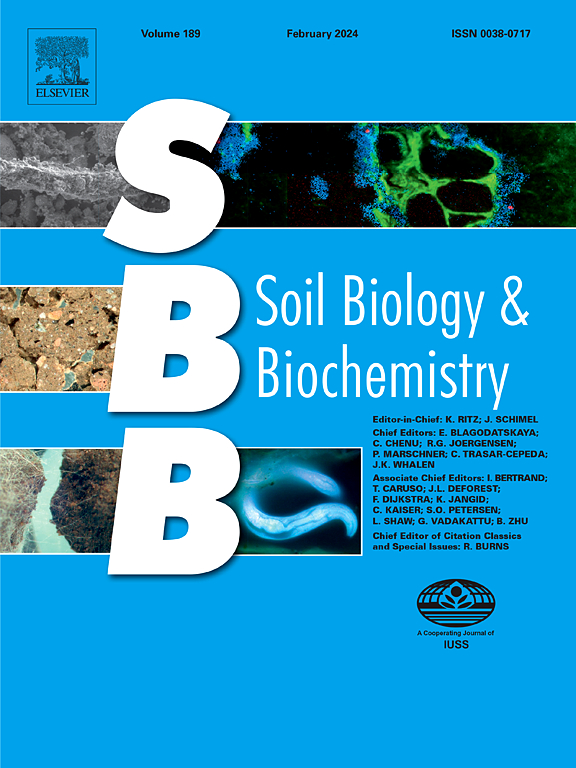Rotational diversity shapes the bacterial and archaeal communities and confers positive plant-soil feedback in winter wheat rotations
IF 9.8
1区 农林科学
Q1 SOIL SCIENCE
引用次数: 0
Abstract
Plant-soil feedbacks drive productivity in winter wheat (WW; Triticum aestivum L.) rotations. Although this is a frequent observation, the underlying plant-soil-microbe interactions remain unclear. We aimed to investigate the effects of WW rotational positions on soil bacterial and archaeal communities, as well as nitrogen (N) cycling, as potential drivers of WW yield decline in successively-grown WW. WW following oilseed rape (W1; Brassica napus L.) was compared with WW in self-succession (W2) in a rhizotron study using agricultural soil with a sandy loam texture. Samples were collected at tillering and grain ripening. At tillering, we found a higher NO3− content in W1 soil, especially in the 60–100 cm subsoil layer, associated with the N-rich residues of the preceding oilseed rape crop, while this trend was reversed at grain ripening. Analysis of enzyme kinetics revealed an increase in leucine aminopeptidase activity in W1 and an increase in β-glucosidase activity in W2 at tillering, possibly related to the residue quality of the preceding crop. No differences in bacterial and archaeal alpha diversity were observed at both sampling times, but beta diversity showed a significant role of both rotational position and soil depth in shaping the microbial community. The gene copy numbers of amoA genes of ammonia-oxidizing bacteria (AOB), nifH and nirS were significantly higher in W2 compared to W1 at tillering, suggesting a strong effect of rotational position on N cycling of the following WW. The abundances of amoA (AOB) and nirS were also higher in W2 at grain ripening. Our results highlight the persistent soil legacy of the preceding crop on both nutrient cycling and bacterial and archaeal community composition, contributing to yield reduction in successively grown WW. Understanding plant-microbe interactions and keeping them at the center of productive WW rotations is, and will continue to be, critical to future agriculture.
在冬小麦轮作中,轮作多样性塑造了细菌和古菌群落,并赋予了正的植物-土壤反馈
植物-土壤反馈对冬小麦生产力的影响小麦轮作。虽然这是一个经常观察到的现象,但潜在的植物-土壤-微生物相互作用仍不清楚。我们的目的是研究WW轮作位置对土壤细菌和古菌群落的影响,以及氮(N)循环,作为WW产量下降的潜在驱动因素。WW继油菜(W1;在砂壤土质农业土壤中,对甘蓝型油菜(Brassica napus L.)与甘蓝型油菜(WW)的自演替(W2)进行根际对照研究。分蘖期和籽粒成熟期采集样品。分蘖期W1土壤NO3-含量较高,特别是60 ~ 100 cm的底土层NO3-含量较高,这与前茬油菜的富氮残留物有关,而在籽粒成熟时这一趋势则相反。酶动力学分析显示,分蘖期W1的亮氨酸氨基肽酶活性和W2的β-葡萄糖苷酶活性均有所增加,这可能与前茬作物的残茬质量有关。细菌和古细菌的α多样性在两个采样时间内没有差异,但β多样性在土壤旋转位置和土壤深度对微生物群落的形成都有重要作用。分蘖期,氨氧化菌(AOB)、氨氧化菌(nifH)和氨氧化菌(nirS)的amoA基因拷贝数在W2显著高于W1,表明轮作位置对后续WW的N循环有较强影响。籽粒成熟时,W2中amoA (AOB)和nirS的丰度也较高。我们的研究结果强调了前茬作物在养分循环和细菌和古细菌群落组成方面的持续土壤遗产,这有助于连续种植WW的产量降低。了解植物与微生物的相互作用,并将其作为高效WW轮作的核心,对未来的农业至关重要。
本文章由计算机程序翻译,如有差异,请以英文原文为准。
求助全文
约1分钟内获得全文
求助全文
来源期刊

Soil Biology & Biochemistry
农林科学-土壤科学
CiteScore
16.90
自引率
9.30%
发文量
312
审稿时长
49 days
期刊介绍:
Soil Biology & Biochemistry publishes original research articles of international significance focusing on biological processes in soil and their applications to soil and environmental quality. Major topics include the ecology and biochemical processes of soil organisms, their effects on the environment, and interactions with plants. The journal also welcomes state-of-the-art reviews and discussions on contemporary research in soil biology and biochemistry.
 求助内容:
求助内容: 应助结果提醒方式:
应助结果提醒方式:


